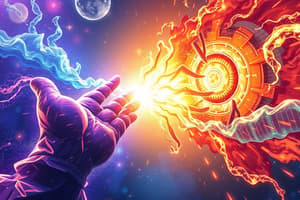Podcast
Questions and Answers
Gravitational Potential Energy (GPE) is associated with an object's motion.
Gravitational Potential Energy (GPE) is associated with an object's motion.
False (B)
When a ball rolls downhill, its Gravitational Potential Energy (GPE) decreases while its Kinetic Energy (KE) remains constant.
When a ball rolls downhill, its Gravitational Potential Energy (GPE) decreases while its Kinetic Energy (KE) remains constant.
False (B)
Kinetic Energy (KE) is quantified based on an object's acceleration and size.
Kinetic Energy (KE) is quantified based on an object's acceleration and size.
False (B)
Elastic Potential Energy (EPE) is generated when an object experiences deformation.
Elastic Potential Energy (EPE) is generated when an object experiences deformation.
As a pendulum swings downward, it converts Kinetic Energy (KE) into Gravitational Potential Energy (GPE).
As a pendulum swings downward, it converts Kinetic Energy (KE) into Gravitational Potential Energy (GPE).
Gravitational Potential Energy (GPE) is highest at the bottom of a hill.
Gravitational Potential Energy (GPE) is highest at the bottom of a hill.
The Kinetic Energy (KE) of an object depends only on its mass.
The Kinetic Energy (KE) of an object depends only on its mass.
Energy transitions between different forms follow the principle of conservation of energy.
Energy transitions between different forms follow the principle of conservation of energy.
Elastic Potential Energy (EPE) is stored in objects at their natural state without any deformation.
Elastic Potential Energy (EPE) is stored in objects at their natural state without any deformation.
Kinetic Energy (KE) is zero when an object is at rest.
Kinetic Energy (KE) is zero when an object is at rest.
Flashcards are hidden until you start studying
Study Notes
Navigating Energy Conversion Diagrams: Understanding Potential, Kinetic, and Elastic Potential Energy
As energy transitions between diverse forms, comprehending the relationships among them is crucial for grasping energy conversion. Three fundamental aspects of potential energy, specifically gravitational potential energy, kinetic energy, and elastic potential energy, play central roles in these connections.
Gravitational Potential Energy (GPE)
Gravitational potential energy (GPE) is associated with an object's position relative to a fixed reference level. For instance, imagine rolling a ball downhill; initially, it possesses GPE before being released and subsequently acquiring kinetic energy (KE) as it descends. GPE diminishes as the ball falls while KE increases, conforming to the principle of conservation of energy.
Kinetic Energy (KE)
Kinetic energy (KE) relates to an object's motion, quantified according to its velocity and mass. As an illustration, consider a pendulum, wherein a bob gains potential energy upon rising and converts it into kinetic energy as it progressively swings downward. Ultimately, its KE peaks just prior to reversal, after which GPE again comes into play.
Elastic Potential Energy (EPE)
Elastic potential energy (EPE) arises within objects experiencing deformation. To envision EPE, picture stretching a rubber band—its natural state holds minimal energy, yet once stretched, it stores EPE waiting to return to equilibrium. Releasing a stretched spring, for example, can be likened to a burst of EPE resulting in kinetic energy.
Energy conversion diagrams visualize the interchange among distinct energy forms, highlighting these principles. They demonstrate that although individual energy quantities may alter throughout cycles, their aggregate remains unchanged. Additionally, they introduce concepts such as energy efficiency, noting that not every conversion yields optimal utilization of input resources. By studying these diagrams and appreciating their underlying physics, we develop a deeper comprehension of the world's intricate energetic systems.
Studying That Suits You
Use AI to generate personalized quizzes and flashcards to suit your learning preferences.




